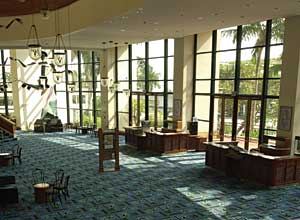How and Why Laminated Glass Solutions Meet Expanding Hurricane Code Requirements
The International Building Code (IBC) defines a windborne debris region as one within hurricane-prone regions within one mile of the coastal mean high water line where the basic wind speed is 110 mph or greater; or where the basic wind speed is 120 mph. The IBC states that glazed openings located within 30 feet of grade shall meet the requirements of the large missile test of ASTM E1996 and glazed openings located more than 30 feet above grade shall meet the provision of the small missile test of ASTM E1996.
 |
| The Broward Center for the Performing Arts in Fort Lauderdale, FL was built before impact resistance requirements were adopted in the building codes.
The 204,000 square foot facility opened in 1991 included 17,100 square feet
of tall windows. After Hurricane Andrew, a decision was made to retrofit
the windows with impact resistant laminated glass. Courtesy of: DuPont Glass Laminating Solutions |
Test protocols for missile impact and pressure cycling are specified in the Florida Building Code, which includes the high velocity wind zone that applies to Miami-Dade and Broward Counties. According to the 2004 Florida Building Code, all Florida counties within the 110-150 mph wind zones have mandatory impact standards except for the northwest Florida Panhandle that specifies impact protection within one mile from the coast.
Hurricane Wilma Aftermath
But it was not until Hurricane Wilma struck South Florida on October 24, 2005, that improved structural building envelope provisions of the building code were put to the test in actual conditions. After causing widespread property damage in Cancun, Mexico, the hurricane made landfall in Southwest Florida near Naples as a Category 3 storm with sustained winds of 103 mph and a very large eye that was 55-65 miles across. The storm exited Florida in northern Palm Beach County only four hours later with the eye still intact and sustained winds of 104 mph. Due to the large size of the storm, heavily populated Dade, Broward and Palm Beach counties all felt the full effect of the winds.
Although the storm was reported to be only a Category 2 storm as it passed through South Florida, there was well-publicized glass breakage in high-rise buildings in Miami, Fort Lauderdale and West Palm Beach and in high-rise condominiums in North Miami Beach. Several buildings on Brickell Avenue in Miami had in excess of 1,000 lites of broken monolithic heat-treated glass. Much of the glass breakage was attributed to windborne debris. Storm investigations by various agencies confirmed that all of the high rise buildings that suffered glass damage were built under codes with lesser hurricane protection standards for high rise buildings than those currently in effect.
In a recent post-Hurricane Wilma study, buildings glazed with impact resistant laminated glass were surveyed to determine the extent of glass breakage and resulting damage to the property. The building types surveyed included condominiums, office buildings, government buildings, hospitals, retail buildings and hotels. Building sizes ranged from single story to multi-story high rises and locations included oceanfront, downtown urban and suburban. Glazing assembly types in the surveyed buildings included sliding glass doors, swing doors, operable windows, fixed glass and curtain wall systems.
Findings confirmed the need for adequate hurricane protection standards. Projects that reported broken or damaged laminated glass from windborne debris only experienced fractures of the glass layers. There were no reports of laminated glass failures resulting in breaches of the building envelope. The laminated glass performed as was intended and consistent with the pass-fail criteria of the Florida Building Code. "The requirement that all structures must have windborne debris protection represents the greatest success story regarding damage mitigation," concluded Miami-Dade County's 2006 Post Hurricane Wilma Progress Assessment.









